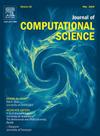Poisson-based framework for predicting count data: Application to traffic counts in Prague areas
IF 3.7
3区 计算机科学
Q2 COMPUTER SCIENCE, INTERDISCIPLINARY APPLICATIONS
引用次数: 0
Abstract
In this paper, we address the task of modeling and predicting count data, with an application to traffic counts on selected urban roads in Prague. We investigated the relationship between multiple counts, designating one of them as the target variable (e.g., data from a key road section) and the others as explanatory counts. Defining traffic count data as the number of vehicles passing through a selected road section per unit of time, we use a framework based on Poisson models to develop a progressive methodology, which we compared with existing models. Working with multimodal count data, we propose the following main steps for the methodology: (i) cluster analysis of explanatory counts using recursive Bayesian estimation of Poisson mixtures; (ii) target count model estimation via local Poisson regressions at identified locations, capturing local relationships between target and explanatory counts; and (iii) prediction of target counts through real-time location detection. The algorithm’s properties were first investigated using simulated data and then validated with real traffic counts. Experimental results indicate that the proposed algorithm outperforms classical Poisson and negative binomial regressions, decision tree and random forest classifiers, as well as a multi-layer perceptron, in predicting traffic count data across various quality metrics, even for weakly correlated data. Applied to traffic count data, the promising performance demonstrated by the proposed algorithm offers an optimistic vision for traffic prediction and urban planning, suggesting its potential as a valuable tool for enhancing transportation efficiency by optimizing the timing of city traffic lights to improve traffic flow.
基于泊松的计数数据预测框架:在布拉格地区的交通计数应用
在本文中,我们解决了建模和预测计数数据的任务,并应用于布拉格选定城市道路的交通计数。我们研究了多个计数之间的关系,指定其中一个作为目标变量(例如,来自关键路段的数据),其他作为解释计数。将交通计数数据定义为单位时间内通过选定路段的车辆数量,我们使用基于泊松模型的框架来开发一种渐进式方法,并将其与现有模型进行比较。使用多模态计数数据,我们提出了以下主要步骤的方法:(i)使用泊松混合物的递归贝叶斯估计对解释性计数进行聚类分析;(ii)通过确定地点的局部泊松回归来估计目标计数模型,捕捉目标计数和解释计数之间的局部关系;(三)通过实时位置检测预测目标数量。该算法的特性首先用模拟数据进行了研究,然后用真实的流量计数进行了验证。实验结果表明,该算法优于经典的泊松和负二项回归、决策树和随机森林分类器以及多层感知器,即使对于弱相关数据,也能预测各种质量指标的流量计数数据。应用于交通计数数据,所提出的算法表现出的良好性能为交通预测和城市规划提供了乐观的前景,表明它有潜力作为一种有价值的工具,通过优化城市交通信号灯的时间来提高交通效率,从而改善交通流量。
本文章由计算机程序翻译,如有差异,请以英文原文为准。
求助全文
约1分钟内获得全文
求助全文
来源期刊

Journal of Computational Science
COMPUTER SCIENCE, INTERDISCIPLINARY APPLICATIONS-COMPUTER SCIENCE, THEORY & METHODS
CiteScore
5.50
自引率
3.00%
发文量
227
审稿时长
41 days
期刊介绍:
Computational Science is a rapidly growing multi- and interdisciplinary field that uses advanced computing and data analysis to understand and solve complex problems. It has reached a level of predictive capability that now firmly complements the traditional pillars of experimentation and theory.
The recent advances in experimental techniques such as detectors, on-line sensor networks and high-resolution imaging techniques, have opened up new windows into physical and biological processes at many levels of detail. The resulting data explosion allows for detailed data driven modeling and simulation.
This new discipline in science combines computational thinking, modern computational methods, devices and collateral technologies to address problems far beyond the scope of traditional numerical methods.
Computational science typically unifies three distinct elements:
• Modeling, Algorithms and Simulations (e.g. numerical and non-numerical, discrete and continuous);
• Software developed to solve science (e.g., biological, physical, and social), engineering, medicine, and humanities problems;
• Computer and information science that develops and optimizes the advanced system hardware, software, networking, and data management components (e.g. problem solving environments).
 求助内容:
求助内容: 应助结果提醒方式:
应助结果提醒方式:


